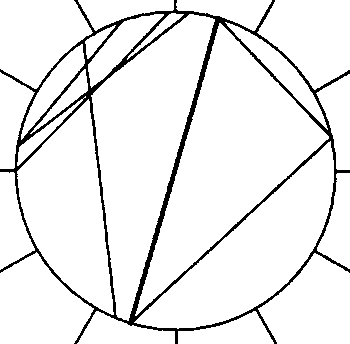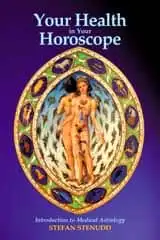|
by Stefan Stenudd
|
The Aspects in the Complete HoroscopeReasons for Actions in Classical Astrology
These are the angles of the major aspects in astrology:
Some astrologers use additional aspects, such as the quincunx (150°) and the semi-sextile (30°), but the above are to all the most important ones. They are also the ones specified by Ptolemy in his classic on astrology, Tetrabiblos. I prefer to stick to these five aspects — they sure make the horoscope chart complex enough. Each aspect represents a kind of relation between the points connected by it:
Order of importanceThe strongest aspect is the conjunction, where planets or other points are very near each other in the chart. The fusion means that they become like one, their separate characters blending, like creating a new planet. You could also call it a synthesis of the forces involved.Second in power is the opposition, where the planets are on opposite sides of the chart. This signifies that the forces of those planets are irreconcilable, impossible to get to work together. They get a relation of "either-or", so that either one planet acts, or the other, but not simultaneously, never joined. The trine shows harmony between planets at that distance. Their forces work for one another, not necessarily through actual cooperation, but still being helpful to each other. The square reveals conflict between the planets involved — conflicting interests that can either be constructive or destructive. The sextile shows active cooperation, where the planets involved concretely aid each other and work together.
OrbAstrologers differ as to how exact the angles should be in order to be called aspects. The tolerance given is called orb. With an orb of 5°, anything from 85° to 95° would be a square, and so on. Some use as big orbs as 10°, but I prefer to use smaller orbs, in order for the chart to really point out strong and relevant aspects. An orb of 4° would do fine.Another solution is to use different orbs for each aspect, in accordance with their strength and importance. Then, something like this would be reasonable:
OriginThe conjunction and the opposition are obvious aspects, but how about the other three? They are connected to relations within the Zodiac circle. The twelve signs of the Zodiac are sorted in three ways: element, quality and charge. Signs of the same element (fire, earth, air or water) are 120° apart, as the trine. Signs of the same quality (cardinal, fixed or mutable) are 90° apart, as the square. Signs of the same charge (positive or negative) are 60° apart, as the sextile.Another influence in the forming of the classic aspects is quite likely to be mathematical. The 360° of the circle divided by 2 is 180°, the opposition, with 3 is 120°, the trine, with 4 is 90°, the square, and with 6 is 60°, the sextile. Division by 5 gives 72°, which is also an aspect, called the quintile, but it is not regarded as particularly significant. Aspects can appear between two planets that are not in the corresponding aspected Zodiac signs, because of the orb allowed. For example, if the sun is in 1° Aries and the moon is in 29° Pisces, they are only at a 2° distance, although in separate signs — so, do they still form a conjunction? They do, but the interpretation of what kind of fusion it is, must take into account what character they get from their separate signs. So, there are four ingredients to mix. I would say, though, that such an aspect is weaker and more subtle than one where the planets are in aspected Zodiac signs as well.
SpeedWhen interpreting birth charts, it's important to remember that in the sky, aspects remain for very different time periods, because of the differing speeds of the planets in their orbits. Here is the time it takes each planet and other astrological point to travel through the whole Zodiac:
Depending on the orb allowed, an aspect between Neptune and Pluto can last for years, even decades, whereas one with the AC or MC can disappear in mere minutes. Very slow aspects are shared by whole generations, and should be interpreted accordingly — for example, with those it is more important in what Houses they are, than the actual aspects themselves. Also, of course, other faster aspects with them should be given special attention. The most rare aspects are the conjunction and opposition of Neptune and Pluto, appearing only every 487 years. Last time they formed such an aspect was their conjunction around the year 1892 at about 8° Gemini.
Special casesYou should also know that the mean positions of the AC and MC are at square distance — more so, the closer you get to the equator. Oppositions between them are almost impossible, and trines quite rare. About Mercury and Venus you should know that they never get that far from the sun, in our geocentric perspective, so they can only form a conjunction with it, and nothing but conjunction or sextile with each other. Mercury is never more than 28° from the sun, Venus never more than 38°.
Progressions and transitsAspects are also the major instruments in making predictions based on the complete horoscope chart. It is done by progression or transit.In progression, what is observed is a theoretical (not actual) advance of the planets In the complete horoscope chart, until they form aspects with other points in it, and the distance traveled equals a certain time gone until that event. In transits, the actual continued movement of the planets is observed. The date when a new aspect is formed with a planet in the birth chart, is the time for an event characterized by the involved planets. I prefer the transit predictions, since the progressions are more difficult to find solid arguments for. When you use the transits, remember that rare aspects are much more important than frequent ones. So, aspects with the transit moon accomplish little more than mood swings, whereas aspects with transit Pluto are probable to change your whole life from that time on.
SymbolsThe symbols used for the aspects are the same in astrology and astronomy. I have made ink brush versions of those symbols, just for fun. Here is a more strict rendering of them:
Aspect symbols (glyphs): conjunction, opposition, trine, square, sextile.
The AspectsHere are the major aspects in astrology, with links to the webpage of each:
MenuCOMPLETE HOROSCOPEHow to Make Your Own HoroscopeYour Health HoroscopeSex in Your HoroscopeZodiac ArchetypesFinancial AstrologyDaily Horoscope Guide — What to ExpectTetrabiblos — the Ancient Astrology BibleHOROSCOPE BASICSZodiac — the "how" of the horoscopePlanets — the "what" of the horoscopeHouses — the "where" of the horoscopeAspects — the "why" of the horoscopeFAMOUS HOROSCOPES2024 presidential election horoscopes for Donald Trump and Joe BidenJoe Biden's 2020 presidential election horoscopePete Buttigieg's 2020 presidential election horoscopeDonald Trump — impeachment horoscopeDonald Trump — will he resign?Hillary ClintonMike PenceBarack ObamaAnders Behring BreivikMichael JacksonSarah PalinBrad PittThe USA Horoscope — Finding and Reading ItPREDICTIONSThe USA Pluto return 2022 horoscopeCapitol attack horoscopeCovid-19 coronavirus horoscopeFuture of the InternetThe Age of AquariusUSA 2016 ElectionMundane Pluto — Its Effect on SocietyMundane Neptune — Its Effect on the ArtsMISCAbout the Complete Horoscope WebsiteDisappearing Ascendant — Latitude EffectsThe Envelope Chart — Horoscope of the PastAstrology LinksAstrologi på svenskaContactCookiesZODIAC SIGNSThe twelve Zodiac signs and what they mean in astrology.
MY OTHER WEBSITES
Tarot Card Meanings
I Ching Online
Stefan Stenudd
About meI'm a Swedish astrologer, author and historian of ideas, researching ancient thought and mythology. My personal website: stenudd.com
|
|||||||||||||||||||||||||||||||||





